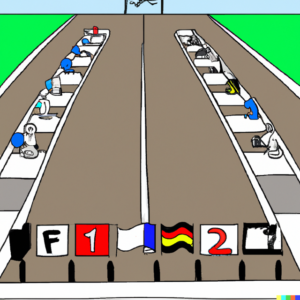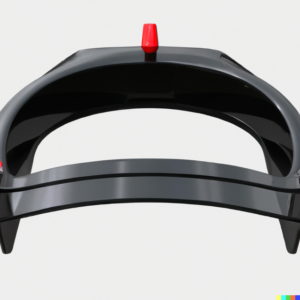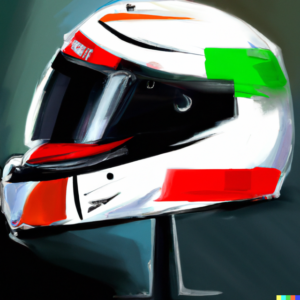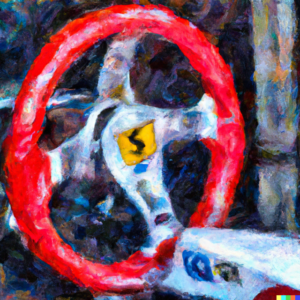What Is Formula 1 DRS

While watching Formula 1 Grand Prix on a Sunday, you might hear the commentators excitedly announce that a driver has DRS.
Even though it’s easy to get caught up in this excitement, you might be wondering exactly what the commentators are getting so hyped about.
In this article, we’ll look at what DRS is, and which rules govern the use of DRS during a Grand Prix race. Go here for a more detailed Beginners guide on Formula 1.
What Is DRS?
DRS stands for “Drag Reduction System”. DRS is a tool used by F1 drivers to reduce their drag and increase their speed. DRS aids with overtaking, especially on the straights.
DRS can be found on the car’s rear wing. This system was introduced in 2011, in an effort to combat driving in dirty air and encourage easier overtaking.
The rear wings of cars have a flap, which opens up to reduce drag. This is known as DRS. Opening up the flap gives the car a speed boost of around 6 to 7.5 mph. This allows drivers to overtake the car driving in front of them.
Once DRS is activated, the rear wing flap lifts up by about 50 mm, which reduces the downforce and drag, allowing the car to speed up.
When DRS was introduced, it was monitored to facilitate overtaking while not impacting driver skill.
Although all tracks have DRS activation zones (more on that later), the usefulness of DRS varies between the tracks. The effectiveness of DRS depends on the downforce of the circuit, the surface of the track, the length of the DRS zone, the corner at the end of the DRS zone, and also the DRS detection point.
How Does DRS Work?
DRS is activated by a button on the driver’s steering wheel. This button causes the flap on the rear wing to open up.
DRS may only be activated in certain areas of the track, known as DRS activation zones. These zones are usually down a straight. Most tracks have two DRS zones, however, a couple of circuits have three.
Drivers can also only use DRS when they are within one second of the car in front of them, even if it is a lapped car. This means even the leading car will be able to use DRS on occasion when he catches up with the back markers (the cars at the back of the race).
The one-second gap between cars is measured at a specific section of the DRS zone, called the DRS detection point. Electric timing tools on the track are able to measure the spacing between two cars, and if the second car is found to be within one second of the front car, the car receives a signal and DRS can be activated in the upcoming zone.
Drivers are notified that they can use DRS by the lights on their steering wheels. The car in front will be notified that the following car has got DRS via the team radio.
The back driver will then activate DRS by pressing a button. The flap is closed and DRS is deactivated when the driver lifts the accelerator pedal or hits the brake pedal. Alternatively, the same button can be used to deactivate DRS.
During Free Practice sessions and Qualifying, DRS can be freely used in the zones, without having a car within one second.
What Are The DRS Rules?
As we’ve mentioned above, DRS cannot be used when the drivers feel like it. There are certain rules that must be followed when drivers want to use DRS to reduce aerodynamic drag.
- The cars must be separated by one second or less.
- DRS can only be used in a DRS zone.
- DRS may not be used within the first two racing laps after the race start, a safety car period, or a race restart.
- DRS may not be used if a safety car is on track. No overtaking is allowed in such an instance.
- DRS may not be used by the driver in front to defend from the pursuing car unless they have a car in front of them that is within one second.
- Drivers may not deploy DRS if racing conditions are considered unsafe, such as during heavy rain. The race director will make the call.
- DRS may be temporarily suspended if there is debris on the track surface.
- DRS can be used unrestricted during practice sessions and qualifying but must be within the designated zones.
The DRS Zone Explained
So we have mentioned the DRS zone a few times, but what exactly is it?
The DRS zone is always on a straight and is an overtaking zone where drivers can activate DRS if the chasing car is within one second of the car ahead.
The zone is marked by a line, called the detection point, as well as a second line, called the activation zone. There is also a track marker with the letters “DRS” on it.
The number of DRS zones on the track differs from circuit to circuit. Usually the main straight (where the starting grid is) will have a zone, as well as one or two additional zones. Cars can reach their top speed in these zones.
FAQs
Is Formula 1 DRS automatic?
DRS in F1 is not an automatic system. It is a manual overtaking aid.
When cars cross the detection point, drivers of the pursuing car are notified that they can activate DRS through their steering wheel dash.
Drivers can then push a button that will open the flap. The system is deactivated once the driver starts braking.
Although the DRS system is not automatic, the DRS detection is.
Which other motorsports use DRS?
The drag reduction system is used by Formula 2, Formula 3, Formula Renault 3.5, Deutsche Tourenwagen Masters, and Super Formula.
What is a DRS train?
A DRS train occurs when several cars are within one second of each other. This means that each car in the train gets DRS, making it incredibly difficult to overtake cars in front of you, as they all have their DRS flaps open.
Sources: F1education





